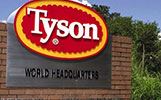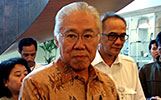| Meat Leader Tyson Foods Goes For Protein Alternatives 
Seth Burton, Facts Reporter | October 21, 2016
Tyson Foods (NYSE:TSN), the Arkansas–based food industry leader, is aiming to reduce the consumption of pork, beef, and chicken in the country by introducing plant proteins. The largest meat processor in the United States, Tyson is the first meat company that is apparently going against its business objectives.
Recently, the company announced that they were acquiring a 5 percent stake in the California firm, Beyond Meat, which makes "meats" from sources of proteins such as peas and soy. A plant–protein, their Beyond Burger started selling earlier this year. Terms of this deal have, however, not been disclosed.
In recent months, Beyond Meat has garnered a lot of praise for coming out with meat alternatives that are made from ingredients like pea flower and carrot fiber.
And to contrast with that here is a Vegan's take on the Beyond Meat Burger: | Beyond Meat and Veggie Grill Partner on 'Bleeding' Burger Organic Authority
Jill Ettinger, Organic Authority | October 29, 2016
Veggie Grill—the fast–casual all vegan restaurant chain has just added a game–changing burger to its menu: Beyond Meat's Beyond Burger.
Beyond Meat, the El Segundo, Calif., based plant meat company has had an exciting few months. After the success of its initial Whole Foods launch of its Beyond Burger over the summer—the veggie burger that's nearly indistinguishable from beef (it sold out in less than an hour—from the meat counter, no less)—the company also secured funding from Tyson Foods, the world's largest producer of meat, poultry, and pork products for a five percent stake in the business.
The Beyond Burger is being served in a traditional burger style: iceberg lettuce (yes, it still exists!), tomatoes, a slice of melting vegan cheese, special sauce, and, of course, a sesame seed bun. It's served with a generous side of fries.
There are many reasons the Beyond Burger is such a hit: it's got a dense meaty texture that much more resembles beef burgers than the brown rice and lentil patties that have passed as burgers for years. There is indeed a pinkness—a fleshy feel—to the burger, which comes from the juice of beets instead of the juice of what was once a thousand–pound steer. | Swedes Re–Invent On–Farm Slaughter
Gordon Davidson, The Scottish Farmer | October 30, 2016
Swedish company Hälsingestintan has come up with a novel idea to improve beef animal welfare and meat quality – mobile abattoirs that visit the animals' home farm, entirely removing any live transport from the food chain.
The two–trailer abattoir trailer design is completely autonomous, with its own electricity, water and heating, offices and changing rooms, slaughterhouse, and a cold store for the meat. It goes directly to the farm, a veterinarian is on hand to ensure good animal welfare, and the animals are lead to the slaughter wagon by the farmer, who of course is very well known to them.
Having pioneered the concept in Sweden, the man behind the company, Franck Ribière, is now taking Hälsingestintan to France, and hopes that its stress–free model will be taken up in other countries where consumers appreciate the link between animal welfare and eating quality.
"We are passionate about providing ethical meat to our consumers," said Mr Ribière. "We are dedicated to good animal welfare and high quality meat. Our ethical concept for meat production eliminates all slaughter transportation, thus improving animal welfare, as the cattle are slaughtered on the farm in their familiar home environment and avoid stressful transportation.
It is interesting that there are calls to protect grazing land in India. While home to the largest dairy herd in the world, and thus also a large exported of beef from both cattle and buffalo, India is also home to the largest vegetarian population in the world. The importance of livestock to their food system and livelihoods must not be underestimated.
National Legislation Required to Reserve Land for Cattle Grazing: Veterinary Experts
Chandigarh Tribune | October 23, 2016
Veterinary scientists from across the country called upon the Union government to initiate national legislation to earmark and protect land for cattle grazing in India. They gave a clarion call to the Centre and state governments for making serious efforts for livestock development as shrinking land was proving fatal for cattle, its health and survival.
Experts and academicians, including vice–chancellors of the eight veterinary universities in the country, converged for the two–day long deliberation on "Sustainable livestock development for food and nutritional security: Way forward" at Khalsa College of Veterinary and Animal Sciences (KCVAS).
Cheap Frozen Indian Buffalo Meat Undercuts Australian Beef in Indonesia, with Some Consumers Unaware of Difference 
Carl Curtain, ABC Online, Rural AU | October 25, 2016
Head of commodities for BMI Research Aurelia Britsch, who authored the report into India's beef exports, told ABC Rural the carabeef was an easily–sourced alternative protein.
"Beef prices in Indonesia have been growing very fast over recent years because the market is very tight," she said. "There is not enough meat in the country and the government is keeping quite a tight grip on the import level.
Northern Australia Secures $98m for Key Cattle Transport Routes as Part of Beef Roads Funding
Carl Curtain, ABC Online, Rural AU | October 23, 2016
Key cattle transport routes in northern Australia have been targeted for funding under the Federal Government's beef roads program.
The announcement comes 18 months after $100 million was first pledged and after a series of meetings were held with the cattle industry in Queensland, the Northern Territory and Western Australia.
Of the $98 million tabled on Monday, Queensland will receive $56 million, the Northern Territory secured $30 million, and Western Australia will receive $12 million.
Australia to Invest in Indonesian Cattle Breeders, Minister Says 
Anton Hermansyah. The Jakarta Post | October 25, 2016
Australia aims to invest in Indonesia's cattle breeding industry, for which it has expressed its readiness to adapt to the latter's new "5–plus–1" import policy, a minister has said. Trade Minister Enggartiasto Lukita said under the new policy, the Indonesian government was committed to import one cow intended for breeding for every five cattle imported for feedlotting.
Such a policy would hopefully encourage local–breeding businesses, increase cattle populations and in the end, reduce beef imports, he went on. | |
